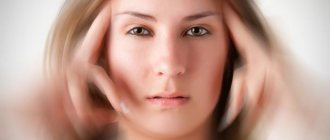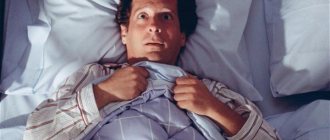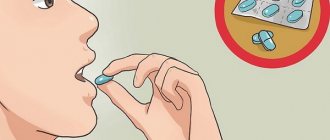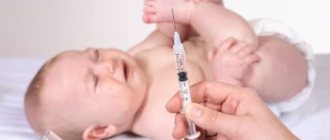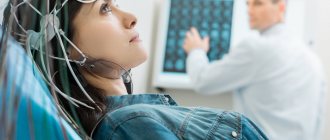Loss of orientation in space: reasons
It is important to know the causes of disorientation in order to provide first aid in an emergency.
What could be the reason for the loss of disorientation in space? There are several of them:
- Alzheimer's disease;
- meningitis;
- renal failure;
- hypothyroidism; schizophrenia;
- hydrocephalus;
- epilepsy;
- Creutzfeldt-Jakob disease;
- manic-depressive disorders;
- encephalitis;
- hypoglycemia;
- brain tumors and cysts.
Note that the causes of disorientation can be not only this kind of illness, but also:
- altitude sickness;
- alcohol abuse;
- taking drugs or certain medications (tranquilizers, antiallergic drugs, painkillers, anti-inflammatory drugs, muscle relaxants);
- hypovitaminosis;
- dehydration;
- hypothermia;
- heatstroke;
- traumatic brain injury;
- infection;
- metabolic disorders;
- post-traumatic psychosis.
With improper nutrition, namely: insufficient intake of nutrients into the body, the brain begins to starve just like the body. Confusion and low blood sugar levels, and as a result, disorientation in space, are some of the consequences of improper diets.
In any case, and regardless of the reasons for the occurrence of such a condition, you should first contact a neurologist. Only a doctor, by conducting an examination and prescribing tests, can diagnose the true causes of disorientation in space.
There is a classification of orientation disorders, one of which is spatial disorientation; accordingly, there are general symptoms of loss of orientation, and there are those related specifically to loss of disorientation in space.
One of the first and main symptoms accompanying disorientation in space. It can intensify with a sharp change in body position or turning the head. Internal causes include improper blood flow, the appearance of which is caused by an uncomfortable position when sitting or lying down. It can cause nausea, vomiting, darkening of the eyes, and pain in the forehead.
Social disorientation manifests itself due to various reasons associated with diseases and pathological conditions. In children, this syndrome may be associated with sudden changes in life, for example, with the start of kindergarten or school.
In young children, the manifestation of social disorientation is a physiological phenomenon. A small child is not able to correctly identify his own gender or occupation; he has difficulty finding his way around a group of new people. Only in adolescence does a period of full social orientation begin.
Disorientation in humans is often associated with organic brain damage, as well as metabolic disorders. In older people, confusion and disorientation are often associated with
Confused consciousness can result from hypoxemia, which manifests itself in diseases of the lungs, as well as the nervous and cardiovascular systems. This symptom can occur with severe infections, severe malnutrition, and dehydration.
Thus, confusion may be a symptom of the following diseases: Alzheimer's disease, brain tumor, circulatory disorders in the brain, head injuries, hypoxemia, endocrine disorders, metabolic disorders.
Confusion of consciousness also manifests itself under the influence of certain external factors. Impaired consciousness is possible with severe hypothermia or heat stroke. Often this symptom is observed in people who have been intoxicated for a long time, taken drugs or potent psychotropic medications.
- Autopsychic - a person loses the ability to self-identify, cannot correctly recognize himself as a person.
- Allopsychic - loses orientation in space.
- Double - the patient simultaneously resides in two realities, real and imaginary.
- Mixed or total - combines several types of disorientation described above.
Depending on the variety, disorientation is accompanied by the following symptoms:
- dizziness;
- sudden mood swings;
- problems with sleep, insomnia, anxiety;
- memory impairment, forgetfulness;
- a feeling of unreasonable fear and anxiety.
It is classified as a mental disorder and can cause certain changes in the central nervous system. It is divided into short-term and long-term, depending on a number of factors. The patient is not able to describe himself as a person, there is no temporal and spatial orientation.
It should not be confused with childhood social disorientation, which is a temporary age-related process. The phenomenon is divided into two types: allopsychic, autopsychic. In the first case, there is an inability to determine location, as well as to separate time periods. In the second case, it is impossible to name the first name, last name, patronymic, date of birth, place of residence.
For diagnosis, the right questions are asked and clarity is established. If it is confused, an urgent consultation with a psychotherapist is necessary. For placement in a psychiatric hospital, the voluntary consent of the individual requiring medical assistance is required. Impaired consciousness makes it impossible to objectively assess the situation; hospitalization is carried out according to the estimated condition at the time of treatment. Direct relatives and family members can help expedite legal issues.
Sometimes you can determine the cause and correct the triggering factors yourself. This applies to alcohol intoxication and lowering blood sugar levels. When your sugar level drops, sweet tea or candy will help. If you lose a large amount of fluid, you should resort to rehydration therapy using products available at the pharmacy. Absorbents and plenty of liquid will help against alcohol intoxication.
Treatment is carried out taking into account the causes of spatial disorientation, the degree of disorder, and the general condition of the patient. The main therapy is aimed at eliminating injuries, neurological and endocrinological pathologies, diseases of the heart, blood vessels, and digestive tract. Correction of emotional disturbances and external signs of illness is carried out in different ways:
- Pharmacotherapy. Psychostimulants, tranquilizers, neurometabolic stimulants, sedatives, angioprotectors, vitamins, and mineral complexes are prescribed. Analgesics and non-steroidal anti-inflammatory drugs help to get rid of pain after injuries.
- Physical rehabilitation. The body will benefit from exposure to a magnetic field, laser, therapeutic physical training, yoga, swimming, massage.
- Surgical intervention. They are performed for special indications when the patient’s life and health are in danger and it is impossible to cure the disease with conservative methods.
- Psychological and pedagogical assistance. Psychocorrectional classes are aimed at training memory, developing thinking and attention. The psychologist will select the optimal model of behavior, give recommendations on how to care for the patient, and how to properly organize the daily routine.
The following reasons for the occurrence of the phenomenon of confused consciousness are identified:
- traumatic (consequences of penetrating traumatic brain injury);
- in case of brain injury (organ tissues are highly sensitive);
- the occurrence of an aneurysm (an enlarged blood vessel affects neighboring tissues);
- mercury poisoning;
- increased dose of alcohol in the blood;
- drug intoxication;
- effects of neurotropic gas on the respiratory system;
- entry of organophosphorus compounds into the digestive system;
- poisoning with neurotoxic substances – puffer fish, mushrooms, carambola;
- hyperthermia resulting from infectious diseases;
- pain shock during a fracture, dislocation, significant blood loss;
- severe diseases - tuberculosis, encephalitis, diabetes mellitus, all types of hepatitis, acquired human immunodeficiency syndrome at the final stage of development;
- progression of tumor growth at the last cancer stage (intoxication occurs during the process);
- ischemic disease, all types of strokes, occurring both unnoticed and obvious;
- myocardial infarction, with pronounced pain and impaired blood flow;
- vegetative-vascular dystonia – vasodilation occurs in areas of the body’s autonomic system;
- age-related diseases: senile dementia, Alzheimer's disease, marasmus of all types;
- bright emotional outburst;
- hypothermia;
- a period without sleep for a long time;
- oxygen starvation;
- 1st and 2nd degree stunning.
Root causes often cause characteristic symptoms to appear. With VSD, obvious vegetation and moderate pain are visible; with a heart attack, the pain syndrome is very pronounced and can sometimes cause a state of shock. Metabolic causes are usually accompanied by various characteristic manifestations, such as odors.
https://www.youtube.com/watch?v=ZY4yQ2bLjLM
Most often, there is a disturbance in orientation in space (the patient is not aware of where he is) and in time (he forgets dates and days). Both options can be combined.
There are also temporary and real disorientation. The first is characterized by a lack of clarity of thinking and forgetfulness.
True confusion is usually the result of illness, injury, or a side effect of medications.
Children and adolescents may experience social disorientation due to major life changes. Young children have difficulty distinguishing between gender and occupation, and they are disturbed by the company of strangers. This is considered a normal physiological phenomenon that goes away during adolescence.
In other conditions, disturbances of consciousness require specialist consultation, since they may be a sign of serious diseases (dementia, mental retardation).
- A person does not recognize the place in which he is, even if it is his home or another well-known place;
- forgets where he lives, where he came from and where he was going;
- suffers from illusions, that is, an incorrect perception of what is happening around;
- experiences psychological discomfort, becomes silent, tries to move less.
- metabolic disorders (metabolic disorders);
- poisoning, including medicinal poisoning;
- brain damage as a result of injury or surgery;
- taking alcohol or drugs, including hallucinogens (most often in this case, confusion is a manifestation of delirium - a state of severe agitation that may be accompanied by illusions and hallucinations);
- senile dementia - in this case, the predominance of memory disorders comes to the fore.
Treatment of disorientation
Basic therapeutic tactics are determined by the main confirmed diagnosis. Etiological treatment methods are varied and may include surgical interventions, for example, for a brain tumor, drug therapy with antipsychotic drugs, and diet therapy. If you suddenly lose orientation in space, you need to calm down and use breathing and relaxation techniques. In some cases, it is enough to restore the usual level of blood sugar, replenish the amount of fluid in the body, and normalize body temperature.
Conservative treatment
General therapeutic measures for the first manifestations of disorientation include ensuring peace, eliminating the effects of stress factors, emotional and mental stress. Patients are advised to have a nutritious diet, maintain a fluid regime, and avoid drinking alcohol, drugs, and medications that can cause disorientation (cancellation must be approved by the attending physician). After seeking medical help and establishing a diagnosis, treatment is carried out using conservative methods:
Corrective classes. Restorative treatment strategies are aimed at optimizing reduced cognitive functions and practical skills. Classes consist of various exercises that train the ability to navigate, create a route, find a way to a given point
The “reverse sequence” technique is used with gradual sequential development of the path, memory training exercises, and the ability to direct attention to landmarks.
Compensation methods. Compensatory strategies involve teaching the patient how to adopt new ways of thinking and behaving to circumvent existing cognitive deficits.
Visual-spatial cues, sound and light signals are actively used to report errors. For example, patients with directional disorientation are taught to make maximum use of the ability to navigate according to the egocentric coordinate system.
Drug therapy. The most common medications for eliminating the symptom of disorientation are nootropics. They stimulate the activity of higher mental functions and enhance the effect of training and rehabilitation activities. In the presence of emotional and behavioral disorders, antipsychotics, tranquilizers, antidepressants, and drugs with a sedative and hypnotic effect are additionally prescribed.
Experimental treatment
Currently, experimental methods of therapy using virtual reality technologies are beginning to be introduced into practice. They simulate the terrain, allowing for controlled correction of landmark agnosia, egocentric disorientation and directional disorientation. Training in the virtual world is more time-efficient than traditional training. Their implementation is possible in case of movement disorders, since the degree of active physical participation of the patient may vary.
Etiology
Clinicians identify the following predisposing factors for the development of this symptom:
- psychological disorders that led to serious disorders of consciousness;
- frequent stress, severe nervous tension;
- alcohol intoxication or drug intoxication;
- side effects of some medications, especially with regard to psychotropic substances (tranquilizers, antidepressants, sedatives);
- the effects of radiation on the body;
- consequences of anesthesia;
- long-term depression.
Alzheimer's disease can lead to disorientation in space.
Short-term disorientation in time can be observed with a strong blow or severe moral shock. In such cases, quite often, this symptom is supplemented by confusion and fainting.
A one-time manifestation of such a symptom, which is short-term in nature, should not always be regarded as a sign of a certain pathological process. However, consultation with a neurologist is advisable.
Current of development
To correctly establish the primary diagnosis, it is necessary to note the causes of the anomaly. Fundamental experts identify the following factors:
- psychological disorders leading to a serious disorder in consciousness;
- stress, nervous overstrain;
- exceeding the norm of ppm alcohol in the blood;
- drug intoxication;
- medications: tranquilizers, antidepressant tablets, sedative drops;
- long-term exposure to increased background radiation;
- period of recovery from anesthesia;
- progressive depression;
- Alzheimer's disease;
- senile pseudosclerosis;
- vegetative-vascular dystonia;
- schizophrenia;
- hypoglycemia;
- senile dementia;
- lack of water resources in the body;
- insufficient kidney function;
- epileptic disease;
- malignant brain tumor;
- benign brain tumor;
- hyperthermia;
- infection with encephalitis tick.
Disorientation can be observed during a high-power impact and in a large emotional outburst. With this development, fainting often occurs. A one-time case is not a consequence of the occurrence of pathological processes. However, to be on the safe side, a consultation with a psychotherapist is necessary.
Classification
In general, the following types of manifestation of this symptom are distinguished:
- radiation;
- professional;
- spatial (violation of orientation in time, place);
- social disorientation.
From a psychological point of view, there are the following types of this disorder:
- autopsychic - false identification of oneself as an individual or complete loss of self-identification;
- allopsychic - disturbance of orientation in the surrounding world;
- double - in this case the patient is simultaneously or alternately in both a real and an imaginary environment;
- total or mixed form.
Only a doctor can determine the form of the disorder after examining the patient.
https://www.youtube.com/watch?v=yhCabfpLGN0
The following forms of this disorder are distinguished, depending on the etiological factor and the age of the patient:
- hallucinatory;
- manic;
- catatonic;
- confabulatory;
- vascular.
A separate form of symptom is confusion in older people. In this case, the manifestation of such a disorder may not always be caused by one or another illness; the symptom may be a consequence of age-related changes.
What is a confused state?
In this process, the ability to think at an average speed disappears, the clarity and consistency of thoughts is significantly destroyed.
Signs of the disorder are problems with orientation in space and deterioration of attention. Logical thinking disappears and memory is degraded. The highest signs of the psyche change one by one. For example, only speech recognition may be affected. Memory problems are noted, spatial orientation is impaired. There are two types of confused consciousness, depending on the cause of its occurrence - fast and slow.
Manifestations can be one-time or permanent. Dementia and delirium are signs of the latter condition. The integrative function of thinking at the moment of confusion is absent. Along with the expected change, the patient is often silent, moves little, and is depressed outwardly. Illusions and hallucinations accompany the disease. The first arise because the body incorrectly perceives the stimulus, while hallucinations manifest themselves independently. Each person suffers from the disease differently - the determining factor is the underlying cause of the development of the disorder. Slowness of thinking and inconsistency of logical series are emphasized during the first minutes of conversation. Even non-professionals can notice the initial symptoms.
Psychotherapists divide delirium into several classifications: hallucinatory (the ability to see non-existent information); manic (obsession with aggression); catatonic (inability to fully move); confabulatory (twisting of an obvious fact).
Prevention measures
Disorientation is a disturbance in consciousness in which a person cannot think clearly and clearly. The appearance of such a disorder requires a thorough examination and establishment of an accurate diagnosis. If the disorientation of consciousness is caused by taking medications, the attending physician will review their doses or prescribe another remedy.
If confusion overtakes a person by surprise, then you need to try to remain calm, not panic, but analyze the causes of the illness. Often disorientation is a signal of some kind of disease or disorder. In this state, you need to drink a lot, monitor your blood pressure, and check your pulse. Sometimes a specialist will prescribe antidepressants to prevent confusion.
Features of symptoms and types of disorders
Spatial disorientation may be accompanied by the following symptoms:
- a person’s inability to identify himself as an individual - he cannot name the year, current month, country or city in which he is located, his passport details;
- feeling of fear and anxiety for no apparent reason;
- sudden changes in mood - attacks of apathy can be replaced by sudden attacks of aggression.
It should be understood that such a person’s condition can be dangerous not only for himself, but also for others. Therefore, the patient must be taken to a specialized medical facility as soon as possible.
Social disorientation, as a rule, does not have pronounced signs of a mental disorder. However, the following specific symptoms may be observed:
- a person cannot accurately say his age or social affiliation;
- feeling uneasy in an unfamiliar environment.
Symptoms of vegetative-vascular dystonia
This patient’s condition is life-threatening, so you should urgently seek medical help. Self-medication, or even more so ignoring this process, is fraught not only with serious complications, but also with death, since unstable blood pressure can lead to stroke and heart attack.
Sometimes illusions are added - incorrect perception of current events or hallucinations - visual and auditory sensations that do not actually exist. The patient is gloomy, silent, depressed, and inactive.
Differential diagnosis of confusion
Patients with difficulty in orienting themselves in time and surroundings need to consult a psychologist, neurologist, or psychotherapist. In some cases, to make diagnoses and choose a course of treatment, you will need the help of a cardiologist, orthopedist, traumatologist, endocrinologist, and other highly specialized doctors. Initially, the doctor talks with the patient or relatives, collects and analyzes medical history data, and narrows the range of possible diseases.
A detailed study of the state of internal organs and systems, cerebral vessels, dysfunction of which has resulted in spatial disorientation, is obtained using laboratory tests of blood, urine, and hardware diagnostic methods. The latter include:
- magnetic resonance imaging;
- computed tomography;
- radiography;
- ultrasound scanning;
- Dopplerography;
- electroencephalography;
- electrocardiogram.
The network of CMRT clinics conducts a comprehensive examination using the following methods:
- Sepsis.
- Alcohol withdrawal syndrome.
- Metabolic disorders.
- Decrease or increase in the concentration of glucose, sodium, calcium.
- Vitamin deficiency.
- Endocrine diseases (thyroid gland, adrenal cortex).
- Myocardial ischemia.
- Organ failure (renal, respiratory, liver, cardiac).
- Drug poisoning.
- Damage to the central nervous system.
- Dementia.
- Cerebrovascular accident (especially in the area of the non-dominant temporal lobe).
- Intracranial hemorrhage (subarachnoid, subdural).
- Infections (encephalitis, meningitis).
- Injury.
- Tumor (primary or metastases).
- Condition after an epileptic seizure; non-convulsive status.
- Vasculitis with damage to cerebral vessels (SLE, polyarteritis nodosa).
- Malignant neoplasms.
TAM, OAK, SRV, concentration of urea and electrolytes, glucose, liver function tests, calcium ion concentration, arterial blood gases, pH, cardiac enzymes, blood culture.
It may be necessary to determine the concentration of magnesium, porphyrins, thiamine, vitamin B12, folate, thyroid-stimulating hormone, free thyroxine (T4), and amylase activity.
They check what medications the patient is receiving and determine the level of alcohol or medications in the blood.
A CT scan with contrast, lumbar puncture, electroencephalography, blood culture, determination of CRP, serological testing for syphilis and Lyme disease may be required.
X-rays, determination of calcium in the blood, and CT scan of the brain are performed.
If you have such a symptom, you should consult a neurologist or psychotherapist. First of all, the doctor conducts a physical examination of the patient to determine complaints, life history and illness. To make an accurate diagnosis, the following laboratory diagnostic methods can be used:
- blood sampling for general and biochemical studies;
- test for the presence of narcotic substances in the body;
- CT and MRI of the brain;
- psychotherapeutic tests.
The exact diagnostic program will depend on the current clinical picture and general condition of the patient.
Consequences
The lack of therapy, when deprived of the correct orientation and understanding of the environment, can become the beginning of atrophic processes in the brain, leading to partial or complete amnesia, and loss of a number of congenital functions. As a result, a person becomes incapacitated and dangerous to society. The patient needs the constant presence of an outsider, since if he is not aware of the actions, he can cause harm to himself, other persons, and property. If spatial orientation is disturbed, the patient may not find his way home and may get lost.
The prognosis is determined by the underlying disease. Thus, neoplasms in the head put pressure on the vessels, tissues, membranes and other structures of the spinal cord, thereby causing sensory and motor disorders, mental disorders, decreased visual and hearing acuity, and paralysis. Malignant tumors can metastasize to other organs and systems, which can ultimately lead to death. The field of infectious diseases of the nervous system remains chronic headaches, epilepsy, and persistent intracranial pressure.
Recovery
After a major stroke, the patient faces long, often lifelong rehabilitation. Neurological deficits caused by brain cell death cannot be restored. However, the body adapts to life at the expense of neurons that remain unharmed. This is possible if both the patient himself and his relatives are actively interested in independent recovery.
Some stages of rehabilitation are carried out in a hospital or sanatorium, but daily care falls on the shoulders of loved ones. It is recommended to seek help from speech therapists, massage therapists, chiropractors, and specialists in the field of acupuncture.
During the adaptation period, the patient undergoes the following procedures:
- Exposure to low frequency magnetic field;
- Electrophoresis;
- Electrical stimulation with alternating sinusoidal current;
- Ozocerite therapy.
The consequences of a major stroke are treated with medications:
- Instenon, Tanakan, Lipamide - for ischemic damage;
- Gliatilin, Delecit, Actovegin - for hemorrhagic stroke;
- Sirdalud, Menovazin - to restore muscle tone;
- Trittico, Neurol, Coaxil - for depressive states;
- Piracetam, Nootropil - for memory impairment.
Great importance is attached to physical therapy. From the very first days after stroke, motor functions of the limbs should be restored. Exercise therapy also solves problems such as decreased muscle tone, improved blood microcirculation, and prevention of joint contracture.
The more severe the stroke, the more difficult it is to adapt. Therefore, rehabilitation procedures must be carried out every day. This will help restore vital functions and reduce the risk of another stroke attack.
Despite the severity of the condition and obvious prognosis, one must not give up. The resources of the brain have not been studied enough, and it is quite possible that persistent exercise will lead to lasting improvements in health.
We strongly recommend not to self-medicate; it is better to consult your doctor. All materials on the site are for informational purposes only!
My mother (65 years old) suffered a massive ischemic left-sided stroke 7 months ago. Help was provided in the hospital at the end of the third hour, and I immediately fell into a coma. After 5 months, another micro-stroke. The left hemisphere is 70% affected.
The right side is completely paralyzed, sensorimotor aphasia, does not speak, cannot read, write, poorly understands spoken speech! The former chief accountant does not understand basic accounting.
The doctors, seeing the discharge from the hospital, are surprised that she is still alive, and even more so they cannot imagine how she can understand anything! Terrible spasms of paralyzed limbs, at rare intervals! Anticonvulsants don't help. Experiencing terrible moral and physical pain.
Constantly crying! The prognosis is disappointing: he will never speak or walk, rehabilitation is ineffective! People, this is a very terrible disease! Take care of yourself and your loved ones!!! Now there is a lot of information about this, this horror is much easier to prevent than to treat!
Déjà Vu Lyrics
Rigos]I'm not Robin Hood In the wilds of the hood, life is far from good for the boys Sketches, like the tales of Kurt Vonnegut's crypt - You'll be sentenced if you're not wise Walking through places of former glory Before Petroga, we get along through Slavik Peter was always famous for being pretty Hanging out with Alice Logging was and remains a sport Now it's easy at airports After all in her ears before the board is torn off the ground Meets someone on the courts In a disposable glass I shake the bone More than I threw into the last game you won’t throw I pull the shovel for which you follow on a rope To squeeze yours too The more dualistic each choice is The more varics and the more evil our scheme The more They give us more nightmares: Special forces are rummaging around in green spots And we are on [?
Or a house cat, I'll breed a personal kind of person I've never been a street dog
But not a series of unnecessary words. I will be the first who was personally able to do a book hop. They say I'm a two-faced snob. Is this so? Place it on the anatomical table, dissect it. Once your offender is dead. What do you see? Everything was practically nonsense
I’m as simple as three rubles, ask Rigos And at least don’t lie to yourself. For me, Ingria’s land is sacred, like the Zenit’s. Yes, I’m squeaky, ask Vitas. They say to me: “It’s a no-brainer to blame the cue ball. If you’re an asshole, your result is to fuck off. the scoreboard, otherwise it’s like suckers on the track This is rushing, and your flow is scum “This is a diploma, and you are a student, and I’m a teacher This is neither a ghetto, nor a racket, nor fights Bird says, I don’t have rap in me - Okay, there’s no Bird in my rap No matter what I’m stuffed with and stuffed with, my track will talk about it succinctly. How many things, honestly, that are accepted nowadays, have I declared canonical?
No, for free at the battle I send upstarts to sleep on sick leave, like a saryn on a kittyBrra! This is not my party nickname, but I personally will give you cash Oops, the devil has confused you. Zhitukha - down without a trampoline How much will they give for your release without markups, having burned that inside is a bespont, butor? And how many MCs in the game, through my fault, have crap here, and come on, let's bidet to the hotel I'm going, cities are growing around me from under earth, like a 3D model And I don’t know where the gunpowder flasks are, but I believe in them - waterproof gunpowder Rap for us is not Nagovitsyn’s chanson, rap is a restless city under the sky Five years ago I was a beggar in the capital, three years ago Everyone is waiting for the album – Coming soon! I was invited to be a guest at the feature, but Oxxxy plays a stranger’s bit like he’s at home
More on Genius
More on Genius
mislead , to fool, to fool one's brains, to fool one's head, to turn an ox, to refuel one's brains, to compost one's brains, to fool one's head, to twist one's head, to twist one's head, to confuse, to muddy the waters, to confuse one's mind, to fool one's brains, to confuse one's minds, to twist one's head, to twist one's brains , confuse, fool the brains, confuse, confuse
Dictionary of Russian synonyms.
disorient see confuse 2 (confuse 2)
Dictionary of synonyms of the Russian language. Practical guide. — M.: Russian language. Z. E. Alexandrova. 2011.
What diseases does it occur in?
Confusion and temporary loss of orientation can be symptoms of very serious illnesses. If disorientation is accompanied by weakness in the limbs and slurred speech, we can talk about a transient ischemic attack or stroke.
If disorientation is accompanied by a high temperature, there is likely a severe infection in the body.
In any of the above cases, you should immediately consult a doctor.
- poisoning;
- manic-depressive disorders;
- senile dementia;
- metabolic disorders;
- injuries or surgical interventions;
- taking alcohol or drugs.
Symptoms
The problem begins with the patient's attention loss and loss of orientation in the area. This leads to problems with pronunciation and memory. The patient is noted to be silent, depressed, and inactive. Loss of orientation is accompanied by dizziness, headache, confusion, and sleep disturbance.
Doctor's advice. If you have several symptoms accompanying disorientation, contact a neurologist or psychiatrist
Dizziness and headache are signs of disorientation (photo: www.anews.com)
Pathogenesis
Successful navigation in space requires sufficient development and preservation of cognitive activity, including perception, recognition of spatial landmarks, discrimination between the left and right sides of the body, mental representation of space, and spatial memory. Visual information is processed in the primary projection zones of the occipital cortex, then goes to the posterior convexital parietal regions, the lateral surface of the temporal lobe, which ensures the recognition of objects and determination of their location.
The prefrontal cortex is responsible for short-term spatial memory and regulatory functions that implement human movement in space. Thus, the pathogenesis of disorientation is based on a violation of the cognitive component, a pathological change in the activity of brain structures that provide visual-spatial gnosis, mental representation of space, and topographic memory.

